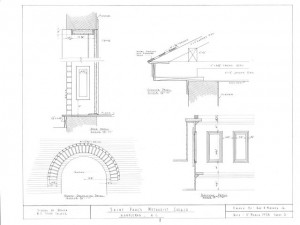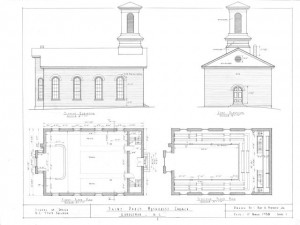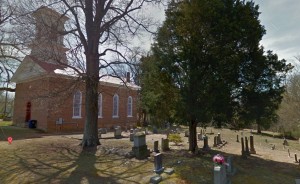 History of St. Paul Methodist Episcopal Church
History of St. Paul Methodist Episcopal Church
In 1855, a Methodist Episcopal Church was organized and was called St. Paul. James Dicks, son of Peter Dicks of New Salem donated the land on which St. Paul now stands. Several other members donated liberally and a wooden church was built. In 1878, John H. Ferree and John Banner Randleman, two of the town’s mill owners, donated money to have the current brick building constructed. This was the first brick church constructed in Randolph County. The church was finished in 1879 but John Randleman died before it was completed.
John Ferree commissioned Peter Clark, a mason, Allen Redding, a carpenter and Jule Gilmer Korner, a local artist to build the church. The cost of the completed building was approximately four thousand dollars. (Peter Clark passed before the church was completed and is buried in the church cemetery.)
About one hundred yards behind the church, near the small stream, clay, dug from the property, was hand pressed and fired in a kiln nearby for bricks for the church. The hand-made bricks were placed on a native rock foundation, cemented with lime, sand, and hickory ashes. Beams of immense size were hand hewn and sized to roof level, to form the peaked top and bell tower. Hand split shingles covered upright walls of the obelisk-like steeple.
The mortar joints of the brick were “penciled” which is a process done to make the large and irregular joints look smaller and more finished.
Large double doors open into the vestibule of the church with stairs on each side leading to the balcony. Originally planned for servants, benches were placed in the balcony. Later, Mr. Ferree built Ferree’s Methodist Chapel and gave the African American congregation their own church.
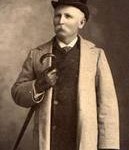 Jule Gilmer Körner (Ruben Rink), a well-known North Carolina artist of the day, painted the entire walls of the balcony and sanctuary with airy designs of draperies, columns, and stained glass windows.
Jule Gilmer Körner (Ruben Rink), a well-known North Carolina artist of the day, painted the entire walls of the balcony and sanctuary with airy designs of draperies, columns, and stained glass windows.
The pulpit sits on a slightly raised platform with a curved pulpit rail. Directly behind the pulpit is a stained glass window which is a memorial to John H. Ferree.
In the 1920’s, the congregation decided to refurbish the interior of the church. They moved the seating from the balcony and divided the area into classrooms. For safety, they placed chicken wire around the balcony edge and pull down shades were used as partitions between “classrooms”.
It was also decided to paint the entire inside of the church covering the original artwork done by Jule Korner. The reason for this and the removal of the original stained glass windows was to allow more light into the church. The original stained glass was replaced with an opaque glass.
The church closed in 1948 when St. Paul merged with Naomi Methodist Episcopal Church to form the First Methodist Church which is now the First United Methodist Church located on Main Street in Randleman, North Carolina.
The building suffered quite a bit of damage during the years that it was abandoned. Many of the opaque windows were broken, a portion of the tin roof on the west side had come loose allowing rain to erode a section of the handmade brick and plaster walls.
The building stood empty until 1966 when the North Randolph Historical Society was formed by a group of concerned Randleman citizens to ensure the preservation of the St. Paul Methodist Episcopal Church and for the preservation of Randolph County’s rich history by collecting, preserving, exhibiting, and interpreting archival materials and physical artifacts associated not only with the history of northern Randolph County, but also with the larger Randolph County community.
In 1968, Mr. Harry Long, minister at the First Methodist Church worked with the society and petitioned the Western Methodist Conference to turn the building over to the society. The conference agreed and sold the building and property fronting the building from Stout Street to the hickory tree on the west side for $1.00.
The society then began the task of making improvements to the building including new electrical wiring, covering the broken windows, installing a used oil furnace, repairing the roof, etc.
There have been several fund raisers and generous donations given to St. Paul. With a 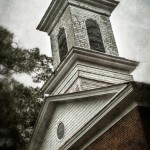 generous donation from Richard Petty, the museum had a new gas heater and air conditioner installed. A donation from the family of Edith Russell and from Howard and Mescal Ferguson allowed artist Carol Robbins to create a painting of St. Paul which providing funding to work on the church steeple. Artist Bill Harris created a painting of Randleman’s old school which helped fund the installation of a new roof for the museum. Money was also raised to replace the old opaque glass windows with new stained glass windows. In mid-2000, the stain glass window in honor of John H. Ferree was restored.
generous donation from Richard Petty, the museum had a new gas heater and air conditioner installed. A donation from the family of Edith Russell and from Howard and Mescal Ferguson allowed artist Carol Robbins to create a painting of St. Paul which providing funding to work on the church steeple. Artist Bill Harris created a painting of Randleman’s old school which helped fund the installation of a new roof for the museum. Money was also raised to replace the old opaque glass windows with new stained glass windows. In mid-2000, the stain glass window in honor of John H. Ferree was restored.
Our latest activity is the restoration of Jule Korner’s interior painting which is being completed by Mr. Andy Compton. The apse portion has been finished which is a gift from Peggy Kirkman Woodlief in memory of her parents, John and Evelyn A. Kirkman, who were long time members of St. Paul.
St. Paul has been called Randolph county’s “hidden gem” which members strive to protect and restore.
Drawings of St. Paul’s (Courtesy of North Carolina State University) (“Click” on drawing to enlarge)
“Click here” for a list of who is buried in the St. Paul cemetery.

